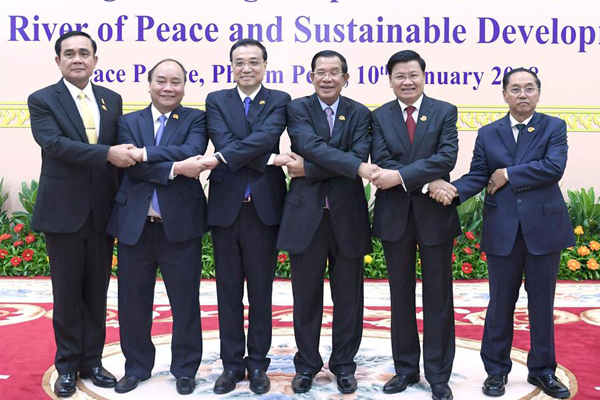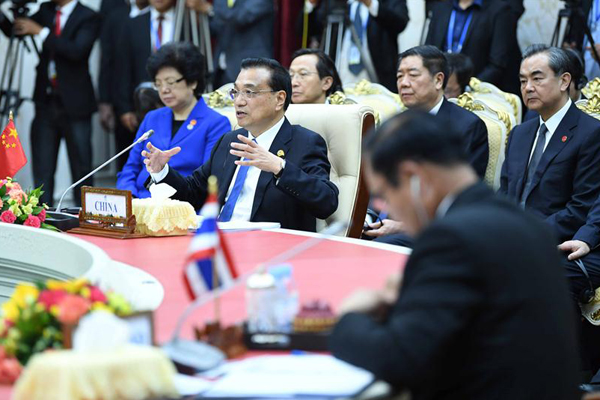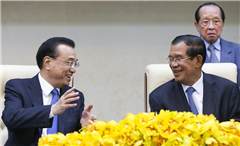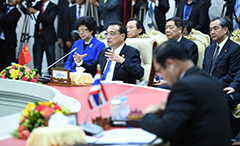China eyes stronger ties with Mekong countries
2018-01-12
Xinhua
 Premier Li Keqiang (3rd L) attends the second Lancang-Mekong Cooperation (LMC) leaders’ meeting in Phnom Penh, Cambodia, Jan 10, 2018. Cambodian Prime Minister Samdech Techo Hun Sen and Li Keqiang co-chaired the meeting, which also brought together Lao Prime Minister Thongloun Sisoulith, Thai Prime Minister Prayut Chan-o-cha, Vietnamese Prime Minister Nguyen Xuan Phuc and Myanmar Vice President U Myint Swe.[Photo/Xinhua]
Premier Li Keqiang (3rd L) attends the second Lancang-Mekong Cooperation (LMC) leaders’ meeting in Phnom Penh, Cambodia, Jan 10, 2018. Cambodian Prime Minister Samdech Techo Hun Sen and Li Keqiang co-chaired the meeting, which also brought together Lao Prime Minister Thongloun Sisoulith, Thai Prime Minister Prayut Chan-o-cha, Vietnamese Prime Minister Nguyen Xuan Phuc and Myanmar Vice President U Myint Swe.[Photo/Xinhua]
PHNOM PENH — China eyes stronger ties with the other five countries along the Lancang-Mekong river, pledging new loans, medical aids and scholarships to its neighbors.
At the second Lancang-Mekong Cooperation (LMC) leaders’ meeting on Jan 10, Premier Li Keqiang announced that China will provide another 7 billion yuan ($1.08 billion) in government concessional loans to Myanmar, Laos, Thailand, Cambodia and Vietnam.
 Premier Li Keqiang attends the second Lancang-Mekong Cooperation (LMC) leaders’ meeting in Phnom Penh, Cambodia, Jan 10, 2018.[Photo/Xinhua]
Premier Li Keqiang attends the second Lancang-Mekong Cooperation (LMC) leaders’ meeting in Phnom Penh, Cambodia, Jan 10, 2018.[Photo/Xinhua]
He also announced the setup of a 5-billion-dollar credit line for supporting production capacity and equipment manufacturing cooperation among the Lancang-Mekong countries.
The new offer came after China supplied the five riparian countries with 10 billion yuan ($1.54 billion) of concessional loans, 5 billion dollars of export credit and 5 billion dollars for capacity cooperation in more than 20 infrastructure and industry projects, Premier Li said.
The deficit that China holds with the Mekong countries on farm product trade will not prevent China from importing more, Premier Li said, adding that protectionism is China’s last choice.
 Premier Li Keqiang, who co-chaired the second Lancang-Mekong Cooperation (LMC) leaders’ meeting with Cambodian Prime Minister Samdech Techo Hun Sen, speaks at a news conference after the meeting in Phnom Penh, Cambodia, Jan 10, 2018.[Photo/Xinhua]
Premier Li Keqiang, who co-chaired the second Lancang-Mekong Cooperation (LMC) leaders’ meeting with Cambodian Prime Minister Samdech Techo Hun Sen, speaks at a news conference after the meeting in Phnom Penh, Cambodia, Jan 10, 2018.[Photo/Xinhua]
With a theme of “Our River of Peace and Sustainable Development,” the meeting brought leaders of China, Myanmar, Laos, Thailand, Cambodia and Vietnam to the table on such issues as connectivity, water management and industrial production capacity.
China is the largest trading partner of Cambodia, Myanmar, Vietnam and Thailand and the second largest of Laos. Bilateral trade between China and the five riparian countries totaled $220 billion in 2017, up 16 percent year-on-year.
Some 80 percent of China’s rice imports are from the Mekong countries. Their fruit exports to China have increased at 21 percent annually over the past decade.
China is the largest source of foreign investment for Cambodia, Laos and Myanmar, and the third and fourth-biggest source for Thailand and Vietnam in 2017, respectively, according to China’s Ministry of Commerce.
Meanwhile, China is willing to offer free medical treatment for major diseases, such as cataract and heart attack, and oral surgery in the Mekong nations, and to launch 100 medical aid projects in the next three years.
China will step up cooperation with the Mekong countries in prevention and control of infectious diseases, carry out cross-border projects on prevention and control of such diseases, and build a network for malaria elimination.
 Premier Li Keqiang, Cambodian Prime Minister Samdech Techo Hun Sen, Lao Prime Minister Thongloun Sisoulith, Thai Prime Minister Prayut Chan-o-cha, Vietnamese Prime Minister Nguyen Xuan Phuc and Myanmar Vice President U Myint Swe, visit an exhibition on Lancang-Mekong cooperation outcomes in Phnom Penh, Cambodia, Jan 10, 2018. [Photo/Xinhua]
Premier Li Keqiang, Cambodian Prime Minister Samdech Techo Hun Sen, Lao Prime Minister Thongloun Sisoulith, Thai Prime Minister Prayut Chan-o-cha, Vietnamese Prime Minister Nguyen Xuan Phuc and Myanmar Vice President U Myint Swe, visit an exhibition on Lancang-Mekong cooperation outcomes in Phnom Penh, Cambodia, Jan 10, 2018. [Photo/Xinhua]
Over the past two years, more than 12,000 students from the Mekong nations received scholarships from the Chinese government. Over 3,000 personnel went to China for training programs.
In 2018, China will offer short-term training and in-service education for 2,000 people from the Mekong countries and 100 four-year scholarships for undergraduates.
As an important mechanism along the Lancang-Mekong river subregion, the LMC mechanism has been focusing on sustainable development and pragmatic cooperation in the subregion and serving as an important platform for implementing the China-proposed Belt and Road Initiative.
Initiated by China in 2014, the framework spans connectivity, production capacity, cross-border economic cooperation, water resources management, and agriculture and poverty reduction, benefiting dozens of millions of people living on the waterway.
The LMC mechanism has produced better-than-expected progress over the past two years as the countries moved forward with the principle of equality and inclusiveness and put development as a priority.
With progress and results delivered daily, monthly and annually, the Premier said a truly remarkable LMC speed had been created, and a defining LMC culture featuring equality, sincerity, mutual assistance and kinship had been established.
The first LMC leaders’ meeting was held in Sanya of China’s Hainan province in March 2016, at which the goal of building a community of shared future of peace and prosperity for the LMC countries was endorsed.
The Lancang River originates on the Qinghai-Tibet Plateau in southwestern China. It is called the Mekong River as it flows through Myanmar, Laos, Thailand, Cambodia and Vietnam before emptying into the sea.






